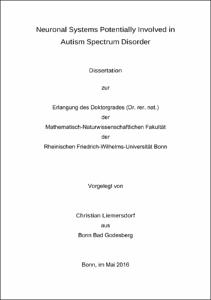Liemersdorf, Christian: Neuronal Systems Potentially Involved in Autism Spectrum Disorder. - Bonn, 2017. - Dissertation, Rheinische Friedrich-Wilhelms-Universität Bonn.
Online-Ausgabe in bonndoc: https://nbn-resolving.org/urn:nbn:de:hbz:5n-46244
Online-Ausgabe in bonndoc: https://nbn-resolving.org/urn:nbn:de:hbz:5n-46244
@phdthesis{handle:20.500.11811/7118,
urn: https://nbn-resolving.org/urn:nbn:de:hbz:5n-46244,
author = {{Christian Liemersdorf}},
title = {Neuronal Systems Potentially Involved in Autism Spectrum Disorder},
school = {Rheinische Friedrich-Wilhelms-Universität Bonn},
year = 2017,
month = jun,
note = {Pfn2 is a brain specific actin binding protein involved in actin dynamics. The Pfn2 knock-out mouse model shows an autistic-like phenotype with all of the features commonly reported in autism patients such as social and communicational impairment, repetitive behavior and epileptic seizures. The role(s) and function(s) of Pfn2 in this striking phenotype are not understood completely. A first step in understanding these roles is investigating the expression pattern of Pfn2 in the brain to shed light on the different neuronal systems that could potentially contribute to the many aspects of the autistic-like and epileptic phenotypes.
A Profilin2-GFP fusion protein knock-in mouse model was used in this thesis to investigate the expression of Pfn2 in neuronal cell subtypes that could possibly contribute to the autistic-like phenotype. Pfn2 has been found expressed in glutamatergic, dopaminergic, serotonergic, adrenergic and cholinergic neurons, both pre- and post-synaptically, while GABAergic neurons showed a complex subtype specific expression pattern dependent on the respective brain area. Pfn2 was missing from all glial cell subtypes. Neural stem cells expressed Pfn2, but stem cell-derived progenitor cells were devoid of Pfn2, but it is re-expressed upon their differentiation into post-mitotic neurons.
The P2-GFP fusion protein is expressed in the knock-in mouse model at reduced levels (app. half) compared to the wt in heterozygous animals. P2-GFP also showed a minor impairment in poly-Lproline binding efficiency (app. 75% of Pfn2), but no changes in G-actin binding efficiency. Nevertheless, P2-GFP was able to bind to nearly all ligands that Pfn2 could interact with including a novel interaction partner, cortactin. The P2-GFP KI mouse model is therefore validated to study Pfn2 trafficking and function in vivo.
Finally, comparative analysis of wt and Pfn2 KO primary hippocampal neuron cultures as a model system revealed that Pfn2 also has a role during neuronal development. Pfn2 KO neurons showed an accelerated neuronal development, reaching each developmental stage faster than wt cells, possibly due to altered actin dynamics. The P2-GFP KI model was then employed to produce mature hippocampal neuron cultures and the trafficking of Pfn2 following different stimulation protocols was studied. Upon application of various stimulants, Pfn2 mostly re-localized into post-synaptic terminals, as previously described, but also into pre-synaptic terminals and, to a lesser extent, into axons. The view of Pfn2 and its function possibly involved in actin-dependent mechanisms during neuronal development as well as during induced synaptic activity requires further studies, but a complex role of Pfn2 in these processes has been discovered with the help of the P2-GFP mouse model as a valuable tool.},
url = {https://hdl.handle.net/20.500.11811/7118}
}
urn: https://nbn-resolving.org/urn:nbn:de:hbz:5n-46244,
author = {{Christian Liemersdorf}},
title = {Neuronal Systems Potentially Involved in Autism Spectrum Disorder},
school = {Rheinische Friedrich-Wilhelms-Universität Bonn},
year = 2017,
month = jun,
note = {Pfn2 is a brain specific actin binding protein involved in actin dynamics. The Pfn2 knock-out mouse model shows an autistic-like phenotype with all of the features commonly reported in autism patients such as social and communicational impairment, repetitive behavior and epileptic seizures. The role(s) and function(s) of Pfn2 in this striking phenotype are not understood completely. A first step in understanding these roles is investigating the expression pattern of Pfn2 in the brain to shed light on the different neuronal systems that could potentially contribute to the many aspects of the autistic-like and epileptic phenotypes.
A Profilin2-GFP fusion protein knock-in mouse model was used in this thesis to investigate the expression of Pfn2 in neuronal cell subtypes that could possibly contribute to the autistic-like phenotype. Pfn2 has been found expressed in glutamatergic, dopaminergic, serotonergic, adrenergic and cholinergic neurons, both pre- and post-synaptically, while GABAergic neurons showed a complex subtype specific expression pattern dependent on the respective brain area. Pfn2 was missing from all glial cell subtypes. Neural stem cells expressed Pfn2, but stem cell-derived progenitor cells were devoid of Pfn2, but it is re-expressed upon their differentiation into post-mitotic neurons.
The P2-GFP fusion protein is expressed in the knock-in mouse model at reduced levels (app. half) compared to the wt in heterozygous animals. P2-GFP also showed a minor impairment in poly-Lproline binding efficiency (app. 75% of Pfn2), but no changes in G-actin binding efficiency. Nevertheless, P2-GFP was able to bind to nearly all ligands that Pfn2 could interact with including a novel interaction partner, cortactin. The P2-GFP KI mouse model is therefore validated to study Pfn2 trafficking and function in vivo.
Finally, comparative analysis of wt and Pfn2 KO primary hippocampal neuron cultures as a model system revealed that Pfn2 also has a role during neuronal development. Pfn2 KO neurons showed an accelerated neuronal development, reaching each developmental stage faster than wt cells, possibly due to altered actin dynamics. The P2-GFP KI model was then employed to produce mature hippocampal neuron cultures and the trafficking of Pfn2 following different stimulation protocols was studied. Upon application of various stimulants, Pfn2 mostly re-localized into post-synaptic terminals, as previously described, but also into pre-synaptic terminals and, to a lesser extent, into axons. The view of Pfn2 and its function possibly involved in actin-dependent mechanisms during neuronal development as well as during induced synaptic activity requires further studies, but a complex role of Pfn2 in these processes has been discovered with the help of the P2-GFP mouse model as a valuable tool.},
url = {https://hdl.handle.net/20.500.11811/7118}
}






